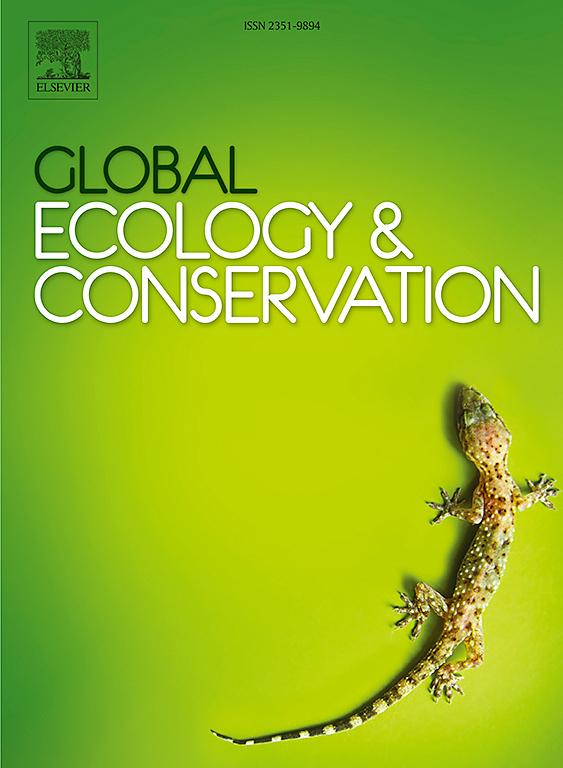利用时空模型预测留尼旺岛上入侵植物的大规模传播
IF 3.5
2区 环境科学与生态学
Q1 BIODIVERSITY CONSERVATION
引用次数: 0
摘要
尽管岛屿生态系统具有高度的物种多样性和地方性,但它们极易受到入侵植物物种(IPS)的侵害。留尼汪岛位于印度洋,是马斯克林群岛中面积最大的完整植被。然而,留尼旺岛的植物群主要受到IPS的威胁。生态建模对于研究岛屿IPS动态和指导岛屿管理决策至关重要。为提高留尼旺岛对入侵入侵植物的管理能力,本研究旨在:(1)在岛屿尺度上预测入侵入侵植物未来的时空动态;(2)更好地了解入侵入侵植物的传播因素。这项工作是通过积极的“研究-行动”伙伴关系进行的。我们设计了一个混合模型来模拟留尼汪岛上IPS随时间的空间分布。我们选择了三种植物进行建模:anthxanthum odoratum, Hiptage benghalensis和Solanum mauritianum。混合模型预测,在重点生物多样性区(KBAs),臭臭草目前的入侵面积将增加30 %;S. mauritianum增加20% %;以及班哈尔支原体在KBAs外的传播。该模型框架基于物种分布模型和属类生命周期机制,可适用于藤本植物、灌木和乔木等不同植物类型的IPS。模式框架也具有适应性,可用于不同的气候变化情景。由于还计划实施入侵入侵控制行动,该模型可作为管理人员分析入侵入侵趋势并采取适当行动的辅助工具。本文章由计算机程序翻译,如有差异,请以英文原文为准。
Massive spread of invasive plant species predicted from spatio-temporal modelling on Reunion Island
Despite their high species diversity and endemism, island ecosystems are extremely vulnerable to invasive plant species (IPS). Reunion Island, located in the Indian Ocean, represents the largest area of intact vegetation in the Mascarene archipelago. However, the flora of Reunion Island is mostly threatened by IPS. Ecological modelling is crucial for studying IPS dynamics and for guiding management decisions on islands. To improve the capacity of IPS management in Reunion Island, this study aimed: (1) to predict the future spatio-temporal dynamics of IPS at island scale, (2) to better understand IPS spread factors. This work was conducted through an active “research-action” partnership. We designed a hybrid model to simulate the spatial spread over time of IPS on Reunion Island. We selected three species to be modelled: Anthoxanthum odoratum, Hiptage benghalensis and Solanum mauritianum. The hybrid model predicted an increase of 30 % of the current invaded surface by A. odoratum in Key Biodiversity Areas (KBAs); an increase of 20 % for S. mauritianum; and a spread outside of KBAs for H. benghalensis. The framework of the model, based on generic life-cycle mechanisms and species distribution models, can be adapted to other IPS of different plant types (such as lianas, shrubs and trees). The model framework is also adaptable and can be used with different climate change scenarios. With the implementation of IPS control actions also planned, the model could be used as a support tool by managers for analysing IPS trends spreading into KBAs and for taking appropriate actions.
求助全文
通过发布文献求助,成功后即可免费获取论文全文。
去求助
来源期刊

Global Ecology and Conservation
Agricultural and Biological Sciences-Ecology, Evolution, Behavior and Systematics
CiteScore
8.10
自引率
5.00%
发文量
346
审稿时长
83 days
期刊介绍:
Global Ecology and Conservation is a peer-reviewed, open-access journal covering all sub-disciplines of ecological and conservation science: from theory to practice, from molecules to ecosystems, from regional to global. The fields covered include: organismal, population, community, and ecosystem ecology; physiological, evolutionary, and behavioral ecology; and conservation science.
 求助内容:
求助内容: 应助结果提醒方式:
应助结果提醒方式:


